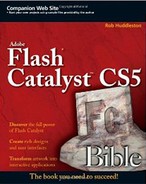In October of 2007, I was sitting in a conference room with members of my team at the interactive agency I worked at. We had been asked if we were interested in meeting with some people from Adobe on some possible features for what was at the time called Flex Builder.
The timing was great because we had recently launched a pretty sophisticated Flex Web application for a car manufacturer, and we had pushed Flex Builder and the Flex framework to its limits. We were thrilled with an opportunity to present all of the issues we had to the team to hopefully work on in the next version.
We sat in the room and dimmed the lights, and the team's product manager, Steve Heintz, made a clarification on the presentation. We weren't going to see Flex Builder, but an entirely new concept codenamed Thermo. As we watched the presentation, the team showed features for this mythical application including:
Converting artwork into components without needing to go through the laborious skinning workflow.
Editing designs in Illustrator within context of the Flex application.
Rigging interactions between components.
Capturing user interactions without needing to understand Flex.
Working with design-time data to build data lists and components.
And all this while writing MXML and ActionScript using the Flex framework behind the scenes.
We were floored, but at the same time were very skeptical — an application like Thermo was exactly what we needed for our recent project where we had a separate team of designers sending over Photoshop files that had to be painstakingly processed and converted into Flex component skins. The process was time consuming and frustrating. Thermo was promising to take the pain out of that workflow, to have the designs and code be connected in an intelligent way, and to allow the designers and developers to each do what they do best. It seemed too good to be true.
With Thermo still in our minds, we hopped on a plane for Chicago to attend Adobe MAX 2007. It was my first MAX, and I was really excited to meet the product teams, evangelists, and community to talk about Flex, Flash and Creative Suite. We were sitting near the front during the keynote and then saw the public unveiling of Thermo.
Note
MAX is a developer's conference hosted every year by Adobe.
"Wow. This is really going to happen," I thought to myself, anxious and salivating for what Adobe was demonstrating to the crowd. It was what everyone talked about the entire conference, and I was proud to have been an early contributor to the product in that first meeting. I was also equally excited when I was able to share that I just had been offered a job at Adobe as a product manager for Creative Suite integration with — you guessed, it — Thermo.
Just as before, I was still skeptical, or at least cautiously optimistic about Thermo, the code name for Flash Catalyst. It promised a lot, and there were big hurdles to overcome, but what struck me about it was how much it was needed.
Before I came to Adobe, managing a team of designers and developers always brought out tons of discussions on what was needed to make the RIA development process easier and more streamlined. It was an issue echoed by the rest of the industry. Flex, ActionScript, Flash — they are all extremely powerful, but they weren't for the timid. You needed to immerse yourself in complex code in order to make significant progress in developing sophisticated applications.
Outside of my day job, I also teach at San Francisco State University. I conduct classes on Flash Professional and ActionScript and also work with students as they build their interactive portfolios to enter into the job market.
Seeing students that are new to Flash and interactive design was an eye-opening experience for me when I saw first-hand that getting started is very difficult. So much of Flash is driven by ActionScript and with the release of ActionScript 3.0, novice and intermediate coders were confused, baffled, and frustrated. Designers that wanted to move beyond print, video pros that wanted to create interactive portfolios, and Web professionals that needed to create exciting Web sites quickly were lost. As Thermo evolved into Flash Catalyst, we worked hard to make it easy to create fun and engaging interactive Web sites, without needing to know the complexities of ActionScript and programming.
Flash Catalyst is for anyone that has a desire to create amazing, interactive Web sites or applications. Regardless if you are an experienced interactive designer, expert ActionScript or Flex programmer, or someone new to interactive design with no coding skills, Flash Catalyst is where you can take your existing skills in design and development and create interactivity like never before.
This book will help you discover all of the great capabilities of Flash Catalyst, as well as how to successfully use it in your workflows with Creative Suite and Flash Builder to create great Web sites and applications using the Adobe Flash Platform.
I would like to thank everyone on the Flash Catalyst team for all of their hard work, long hours, and dedication to deliver a great product. Every person on the team makes me proud to be working on Flash Catalyst. In addition, I want to extend my thanks to the entire Creative Suite team for their faith and dedication to creating a streamlined workflow with Illustrator, Photoshop, Fireworks, and other Creative Suite tools.
I sincerely hope that you enjoy and have fun using Flash Catalyst as much as we had making it.
Doug Winnie
Principal Product Manager
Adobe Flash Catalyst and Flash Platform Workflow
